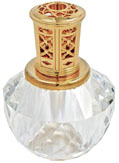
A candle is an ignitable wick embedded in wax, or another flammable solid substance such as tallow, that provides light, and in some cases, a fragrance. A candle can also provide heat or a method of keeping time.

Perfume is a mixture of fragrant essential oils or aroma compounds (fragrances), fixatives and solvents, usually in liquid form, used to give the human body, animals, food, objects, and living-spaces an agreeable scent. The 1939 Nobel Laureate for Chemistry, Leopold Ružička stated in 1945 that "right from the earliest days of scientific chemistry up to the present time, perfumes have substantially contributed to the development of organic chemistry as regards methods, systematic classification, and theory."

Incense is aromatic biotic material that releases fragrant smoke when burnt. The term is used for either the material or the aroma. Incense is used for aesthetic reasons, religious worship, aromatherapy, meditation, and ceremony. It may also be used as a simple deodorant or insect repellent.

A kerosene lamp is a type of lighting device that uses kerosene as a fuel. Kerosene lamps have a wick or mantle as light source, protected by a glass chimney or globe; lamps may be used on a table, or hand-held lanterns may be used for portable lighting. Like oil lamps, they are useful for lighting without electricity, such as in regions without rural electrification, in electrified areas during power outages, at campsites, and on boats. There are three types of kerosene lamp: flat-wick, central-draught, and mantle lamp. Kerosene lanterns meant for portable use have a flat wick and are made in dead-flame, hot-blast, and cold-blast variants.

A flame is the visible, gaseous part of a fire. It is caused by a highly exothermic chemical reaction taking place in a thin zone. Very hot flames are hot enough to have ionized gaseous components of sufficient density to be considered plasma.

A portable stove is a cooking stove specially designed to be portable and lightweight, used in camping, picnicking, backpacking, or other use in remote locations where an easily transportable means of cooking or heating is needed. Portable stoves can be used in diverse situations, such as for outdoor food service and catering and in field hospitals.

Fire eating is the act of putting a flaming object into the mouth and extinguishing it. A fire eater can be an entertainer, a street performer, part of a sideshow or a circus act but has also been part of spiritual tradition in India.

Air fresheners are consumer products that typically emit fragrance and are used in homes or commercial interiors such as restrooms, foyers, hallways, vestibules and other smaller indoor areas, as well as larger areas such as hotel lobbies, auto dealerships, medical facilities, public arenas and other large interior spaces. Car fresheners are used in automobiles. As a source of odors, specific deodorizing blocks are made for toilets and urinals.

A beverage-can stove, or pop-can stove, is a do it yourself, ultralight, alcohol-burning portable stove. The simple design is made entirely from aluminium cans, lending itself to countless variations.
The wick effect is the partial or total destruction of a human body by fire, when the clothing of the victim soaks up melted human fat and acts like the wick of a candle. The wick effect is a phenomenon that is found to occur under certain conditions, and has been thoroughly observed. It is one commonly offered explanation for the alleged phenomenon of spontaneous human combustion.

A candle wick is usually a braided cotton that holds the flame of an oil lamp or candle. A candle wick works by capillary action, conveying ("wicking") the fuel to the flame. When the liquid fuel, typically melted candle wax, reaches the flame it then vaporizes and combusts. The candle wick influences how the candle burns. Important characteristics of the wick include diameter, stiffness, fire-resistance, and tethering.

In combustion, a diffusion flame is a flame in which the oxidizer and fuel are separated before burning. Contrary to its name, a diffusion flame involves both diffusion and convection processes. The name diffusion flame was first suggested by S.P. Burke and T.E.W. Schumann in 1928, to differentiate from premixed flame where fuel and oxidizer are premixed prior to burning. The diffusion flame is also referred to as nonpremixed flame. The burning rate is however still limited by the rate of diffusion. Diffusion flames tend to burn slower and to produce more soot than premixed flames because there may not be sufficient oxidizer for the reaction to go to completion, although there are some exceptions to the rule. The soot typically produced in a diffusion flame becomes incandescent from the heat of the flame and lends the flame its readily identifiable orange-yellow color. Diffusion flames tend to have a less-localized flame front than premixed flames.

A kerosene heater, also known as a paraffin heater, is typically a portable, unvented, kerosene-fueled, space heating device. In Japan and other countries, they are a primary source of home heat. In the United States and Australia, they are a supplemental heat or a source of emergency heat during a power outage. Most kerosene heaters produce between 3.3 and 6.8 kilowatts.

The Primus stove was the first pressurized-burner kerosene (paraffin) stove, developed in 1892 by Frans Wilhelm Lindqvist, a factory mechanic in Stockholm. The stove was based on the design of the hand-held blowtorch; Lindqvist’s patent covered the burner, which was turned upward on the stove instead of outward as on the blowtorch. The same year, Lindqvist partnered with Johan Viktor Svenson and established J.V. Svenson’s Kerosene Stove Factory for manufacturing the new stoves which were sold under the name Primus. The first model was the No.1 stove, which was quickly followed by a number of similarly-designed stoves of different models and sizes. Shortly thereafter, B.A. Hjorth & Co., a tool and engineering firm begun in Stockholm in 1889, acquired the exclusive rights to sell the Primus stove.

The Argand lamp is a type of oil lamp invented in 1780 by Aimé Argand. Its output is 6 to 10 candelas, brighter than that of earlier lamps. Its more complete combustion of the candle wick and oil than in other lamps required much less frequent trimming of the wick.

To a certain extent, all of these techniques tend to produce an extract with an aroma that differs from the aroma of the raw materials. Heat, chemical solvents, or exposure to oxygen in the extraction process may denature some aromatic compounds, either changing their odour character or rendering them odourless, and the proportion of each aromatic component that is extracted can differ.

Eau de toilette is a lightly scented cologne. It is also referred to as aromatic waters and has a high alcohol content. It is usually applied directly to the skin after bathing or shaving. It is traditionally composed of alcohol and various volatile oils. Traditionally these products were named after a principal ingredient; some being geranium water, lavender water, lilac water, violet water, spirit of myrcia and 'eau de Bretfeld'. Because of this, eau de toilette was sometimes referred to as "toilet water".

A luminous flame is a burning flame which is brightly visible. Much of its output is in the form of visible light, as well as heat or light in the non-visible wavelengths.

Aroma lamps, or diffusers, are used to diffuse essential oils in aromatherapy and esoterics. They may project the oil into the air by heating it, letting it evaporate naturally, or nebulizing it using compressed air or ultrasonics.

Flameless candles are an electronic alternative to traditional wick candles. They are typically utilized as aesthetic lighting devices and come in a variety of shapes, colors and sizes. A flame-effect lightbulb contains multiple small light-emitting diodes and a control circuit to flash them in a semi-regular, flickering pattern. The bulb may be sold separately with a standard Edison screw for use in ordinary fixtures, or in a self-contained housing with battery.



















